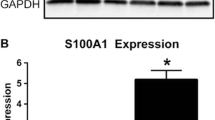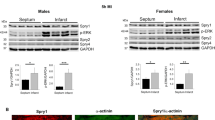Abstract
Background
Abnormal ion channel currents caused by myocardial electrical remodeling is one of the main causes of malignant arrhythmias. Glycogen synthase kinase 3β (GSK-3β) is the main therapeutic target following ischemia as it regulates nerve cell channels. However, few studies have investigated its role in myocardial electrical remodeling. The present study aimed to investigate the role of GSK-3β in a rat myocardial infarction (MI)–induced electrical remodeling and potential effects on cardiac ionic channels including KCNJ2/Kir2.1/IK1.
Methods
Ligation of the left anterior descending artery in rats was performed to establish a MI model. The rats were randomly divided into three groups, the sham, MI, and MI + SB group. The animals in the latter group were administered SB216763 (GSK-3β inhibitor) at a dose of 0.6 mg·kg−1·day−1. The ventricular function was assessed by echocardiography, electrocardiography, and histological analysis 7 days post-surgery. Serum was collected to measure lactate dehydrogenase and cardiac troponin I levels, and the mRNA and protein levels of the KCNJ2/Kir2.1/IK1 channel in the heart tissues were assessed. H9c2 cells were cultured to examine the effects of SB216763 on the protein expression of Kir2.1 channel under hypoxic conditions.
Results
The results revealed that SB216763 ameliorated acute cardiac injury and improved myocardial dysfunction. Moreover, SB216763 increased the mRNA and protein expression of Kir2.1 during MI. Furthermore, SB216763 treatment abrogated the decreased expression of Kir2.1 in H9c2 cells under hypoxic conditions.
Conclusions
GSK-3β inhibition upregulates Kir2.1 expression in a rat model of MI.






Similar content being viewed by others
Change history
26 January 2022
A Correction to this paper has been published: https://doi.org/10.1007/s10840-022-01130-2
References
Anderson JL, Morrow DA. Acute myocardial infarction. N Engl J Med. 2017;376(21):2053–64. https://doi.org/10.1056/NEJMra1606915.
Sanchis-Gomar F, Perez-Quilis C, Leischik R, Lucia A. Epidemiology of coronary heart disease and acute coronary syndrome. Ann Transl Med. 2016;4(13):256. https://doi.org/10.21037/atm.2016.06.33.
Roell W, Klein AM, Breitbach M, Becker TS, Parikh A, Lee J, et al. Overexpression of Cx43 in cells of the myocardial scar: correction of post-infarct arrhythmias through heterotypic cell-cell coupling. Sci Rep. 2018;8(1):7145. https://doi.org/10.1038/s41598-018-25147-8.
Nagini S, Sophia J, Mishra R. Glycogen synthase kinases: moonlighting proteins with theranostic potential in cancer. Semin Cancer Biol. 2019;56:25–36. https://doi.org/10.1016/j.semcancer.2017.12.010.
Saraswati AP, Ali Hussaini SM, Krishna NH, Babu BN, Kamal A. Glycogen synthase kinase-3 and its inhibitors: potential target for various therapeutic conditions. Eur J Med Chem. 2018;144:843–58. https://doi.org/10.1016/j.ejmech.2017.11.103.
Shu Q, Liu J, Liu X, Zhao S, Li H, Tan Y, et al. GABAB R/GSK-3beta/NF-kappaB signaling pathway regulates the proliferation of colorectal cancer cells. Cancer Med. 2016;5(6):1259–67. https://doi.org/10.1002/cam4.686.
Jaworski T. Control of neuronal excitability by GSK-3beta: epilepsy and beyond. Biochim Biophys Acta Mol Cell Res. 1867;2020(9):118745. https://doi.org/10.1016/j.bbamcr.2020.118745.
Wildburger NC, Laezza F. Control of neuronal ion channel function by glycogen synthase kinase-3: new prospective for an old kinase. Front Mol Neurosci. 2012;5:80. https://doi.org/10.3389/fnmol.2012.00080.
van der Heyden MA, Jespersen T. Pharmacological exploration of the resting membrane potential reserve: Impact on atrial fibrillation. Eur J Pharmacol. 2016;771:56–64. https://doi.org/10.1016/j.ejphar.2015.11.026.
Li M, Kanda Y, Ashihara T, Sasano T, Nakai Y, Kodama M, et al. Overexpression of KCNJ2 in induced pluripotent stem cell-derived cardiomyocytes for the assessment of QT-prolonging drugs. J Pharmacol Sci. 2017;134(2):75–85. https://doi.org/10.1016/j.jphs.2017.05.004.
Li X, Hu H, Wang Y, Xue M, Li X, Cheng W, et al. Valsartan ameliorates KIR2.1 in rats with myocardial infarction via the NF-kappaB-miR-16 pathway. Gene. 2016;590(2):201–9. https://doi.org/10.1016/j.gene.2015.11.047.
Li X, Hu H, Wang Y, Xue M, Li X, Cheng W, et al. Valsartan upregulates Kir2.1 in rats suffering from myocardial infarction via casein kinase 2. Cardiovasc Drugs Ther. 2015;29(3):209–18. https://doi.org/10.1007/s10557-015-6598-1.
Atha J, Wheatley DW. The mobilising effects of repeated measurement on hip flexion. Br J Sports Med. 1976;10(1):22–5. https://doi.org/10.1136/bjsm.10.1.22.
Wang S, Su X, Xu L, Chang C, Yao Y, Komal S, et al. Glycogen synthase kinase-3beta inhibition alleviates activation of the NLRP3 inflammasome in myocardial infarction. J Mol Cell Cardiol. 2020;149:82–94. https://doi.org/10.1016/j.yjmcc.2020.09.009.
Gross ER, Hsu AK, Gross GJ. Opioid-induced cardioprotection occurs via glycogen synthase kinase beta inhibition during reperfusion in intact rat hearts. Circ Res. 2004;94(7):960–6. https://doi.org/10.1161/01.RES.0000122392.33172.09.
Providencia R, Karim N, Srinivasan N, Honarbakhsh S, Vidigal Ferreira MJ, Goncalves L, et al. Impact of QTc formulae in the prevalence of short corrected QT interval and impact on probability and diagnosis of short QT syndrome. Heart. 2018;104(6):502–8. https://doi.org/10.1136/heartjnl-2017-311673.
Hulsmans M, Clauss S, Xiao L, Aguirre AD, King KR, Hanley A, et al. Macrophages facilitate electrical conduction in the heart. Cell. 2017;169(3):510–22 e20. https://doi.org/10.1016/j.cell.2017.03.050.
Lv D, Bai Z, Yang L, Li X, Chen X. Lipid emulsion reverses bupivacaine-induced apoptosis of h9c2 cardiomyocytes: PI3K/Akt/GSK-3beta signaling pathway. Environ Toxicol Pharmacol. 2016;42:85–91. https://doi.org/10.1016/j.etap.2016.01.004.
Liu X, Deng Y, Xu Y, Jin W, Li H. MicroRNA-223 protects neonatal rat cardiomyocytes and H9c2 cells from hypoxia-induced apoptosis and excessive autophagy via the Akt/mTOR pathway by targeting PARP-1. J Mol Cell Cardiol. 2018;118:133–46. https://doi.org/10.1016/j.yjmcc.2018.03.018.
Abd-Ellah A, Voogdt C, Krappmann D, Moller P, Marienfeld RB. GSK3beta modulates NF-kappaB activation and RelB degradation through site-specific phosphorylation of BCL10. Sci Rep. 2018;8(1):1352. https://doi.org/10.1038/s41598-018-19822-z.
Mankad P, Kalahasty G. Antiarrhythmic drugs: risks and benefits. Med Clin North Am. 2019;103(5):821–34. https://doi.org/10.1016/j.mcna.2019.05.004.
Hu XT. HIV-1 Tat-mediated calcium dysregulation and neuronal dysfunction in vulnerable brain regions. Curr Drug Targets. 2016;17(1):4–14. https://doi.org/10.2174/1389450116666150531162212.
James TF, Nenov MN, Wildburger NC, Lichti CF, Luisi J, Vergara F, et al. The Nav1.2 channel is regulated by GSK3. Biochim Biophys Acta. 2015;1850(4):832–44. https://doi.org/10.1016/j.bbagen.2015.01.011.
Fezai M, Ahmed M, Hosseinzadeh Z, Lang F. Up-regulation of the large-conductance Ca2+-activated K+ channel by glycogen synthase kinase GSK3beta. Cell Physiol Biochem. 2016;39(3):1031–9. https://doi.org/10.1159/000447810.
Scala F, Fusco S, Ripoli C, Piacentini R, Li Puma DD, Spinelli M, et al. Intraneuronal Abeta accumulation induces hippocampal neuron hyperexcitability through A-type K(+) current inhibition mediated by activation of caspases and GSK-3. Neurobiol Aging. 2015;36(2):886–900. https://doi.org/10.1016/j.neurobiolaging.2014.10.034.
Hausenloy DJ, Yellon DM. Preconditioning and postconditioning: united at reperfusion. Pharmacol Ther. 2007;116(2):173–91. https://doi.org/10.1016/j.pharmthera.2007.06.005.
Rayasam GV, Tulasi VK, Sodhi R, Davis JA, Ray A. Glycogen synthase kinase 3: more than a namesake. Br J Pharmacol. 2009;156(6):885–98. https://doi.org/10.1111/j.1476-5381.2008.00085.x.
Wagner C, Tillack D, Simonis G, Strasser RH, Weinbrenner C. Ischemic post-conditioning reduces infarct size of the in vivo rat heart: role of PI3-K, mTOR, GSK-3beta, and apoptosis. Mol Cell Biochem. 2010;339(1-2):135–47. https://doi.org/10.1007/s11010-009-0377-x.
Hu Z, Crump SM, Zhang P, Abbott GW. Kcne2 deletion attenuates acute post-ischaemia/reperfusion myocardial infarction. Cardiovasc Res. 2016;110(2):227–37. https://doi.org/10.1093/cvr/cvw048.
Lazzerini PE, Capecchi PL, Laghi-Pasini F. Long QT syndrome: an emerging role for inflammation and immunity. Front Cardiovasc Med. 2015;2:26. https://doi.org/10.3389/fcvm.2015.00026.
Zhai XW, Zhang L, Guo YF, Yang Y, Wang DM, Zhang Y, et al. The IK1/Kir2.1 channel agonist zacopride prevents and cures acute ischemic arrhythmias in the rat. PLoS One. 2017;12(5):e0177600. https://doi.org/10.1371/journal.pone.0177600.
Kushiyama Y, Honjo H, Niwa R, Takanari H, Yamazaki M, Takemoto Y, et al. Partial IK1 blockade destabilizes spiral wave rotation center without inducing wave breakup and facilitates termination of reentrant arrhythmias in ventricles. Am J Physiol Heart Circ Physiol. 2016;311(3):H750–8. https://doi.org/10.1152/ajpheart.00228.2016.
Osadchii OE. Effects of antiarrhythmics on the electrical restitution in perfused guinea-pig heart are critically determined by the applied cardiac pacing protocol. Exp Physiol. 2019;104(4):490–504. https://doi.org/10.1113/EP087531.
Funding
This work was supported by the National Natural Science Foundation of China (No. 81670311).
Author information
Authors and Affiliations
Corresponding author
Ethics declarations
Conflict of interest
The authors declare no competing interests.
Additional information
Publisher’s Note
Springer Nature remains neutral with regard to jurisdictional claims in published maps and institutional affiliations.
Rights and permissions
About this article
Cite this article
Chang, C., Wang, SH., Xu, LN. et al. Glycogen synthase kinase 3 beta inhibitor SB216763 improves Kir2.1 expression after myocardia infraction in rats. J Interv Card Electrophysiol 63, 239–248 (2022). https://doi.org/10.1007/s10840-021-00963-7
Received:
Accepted:
Published:
Issue Date:
DOI: https://doi.org/10.1007/s10840-021-00963-7




